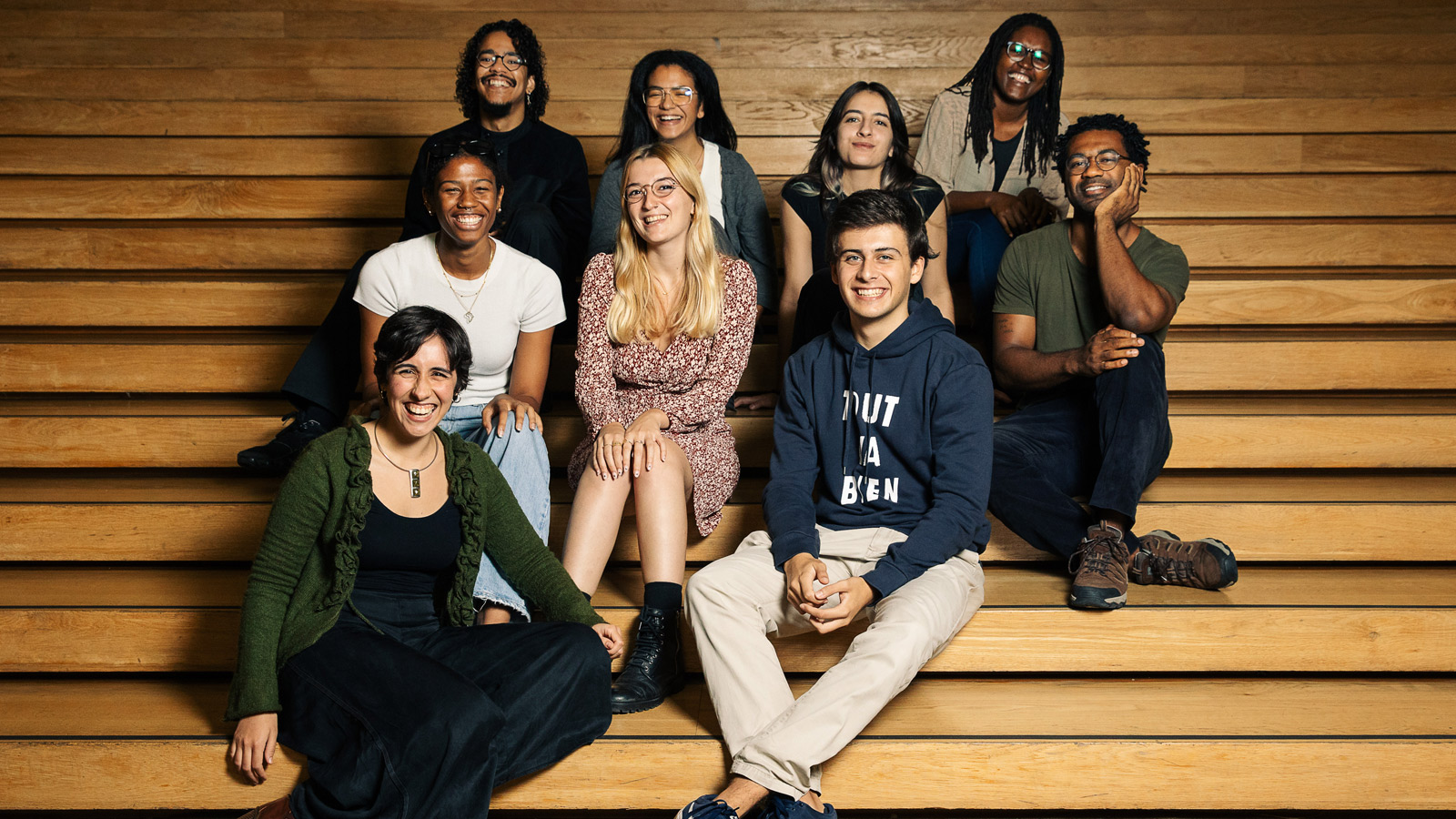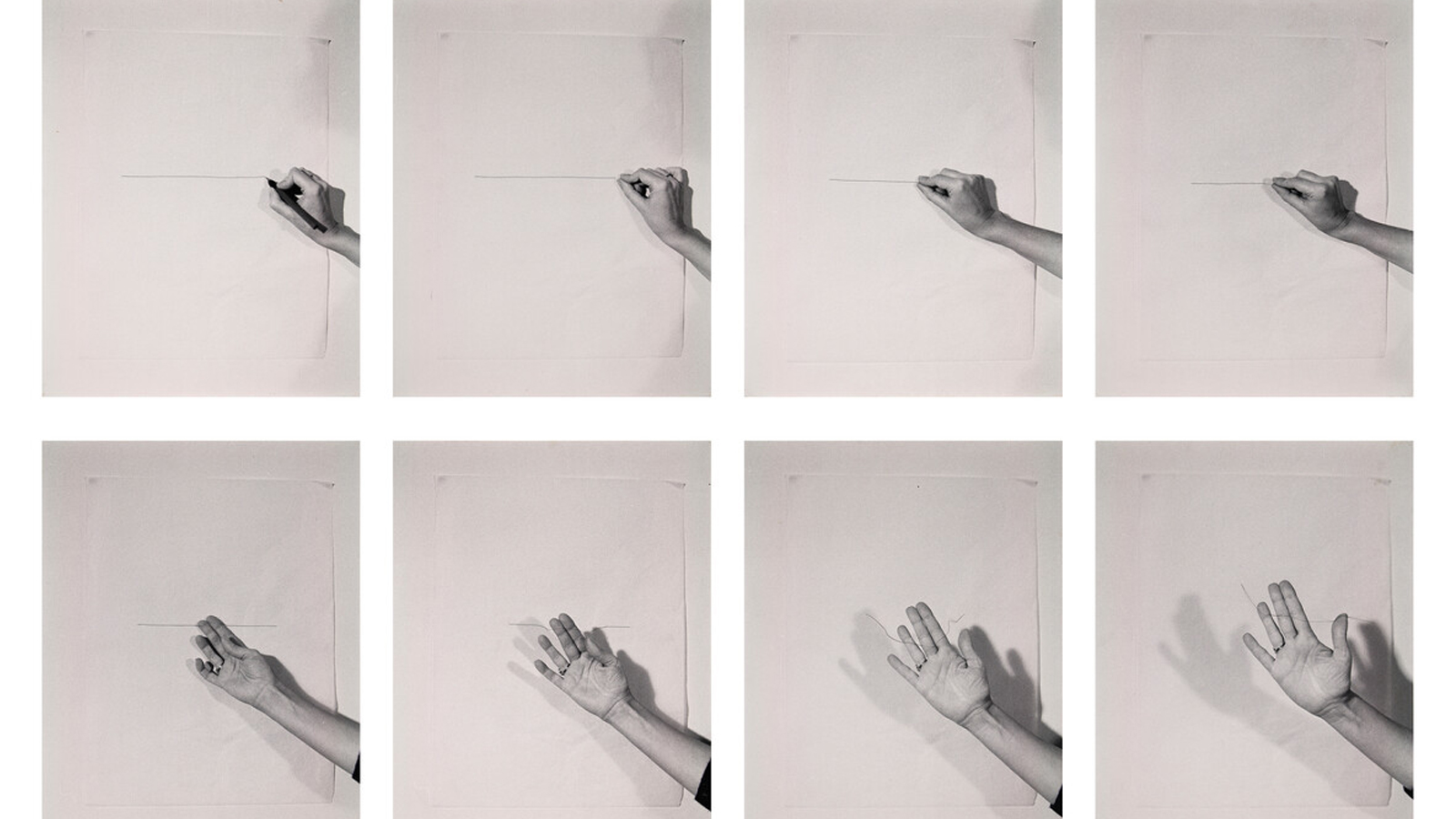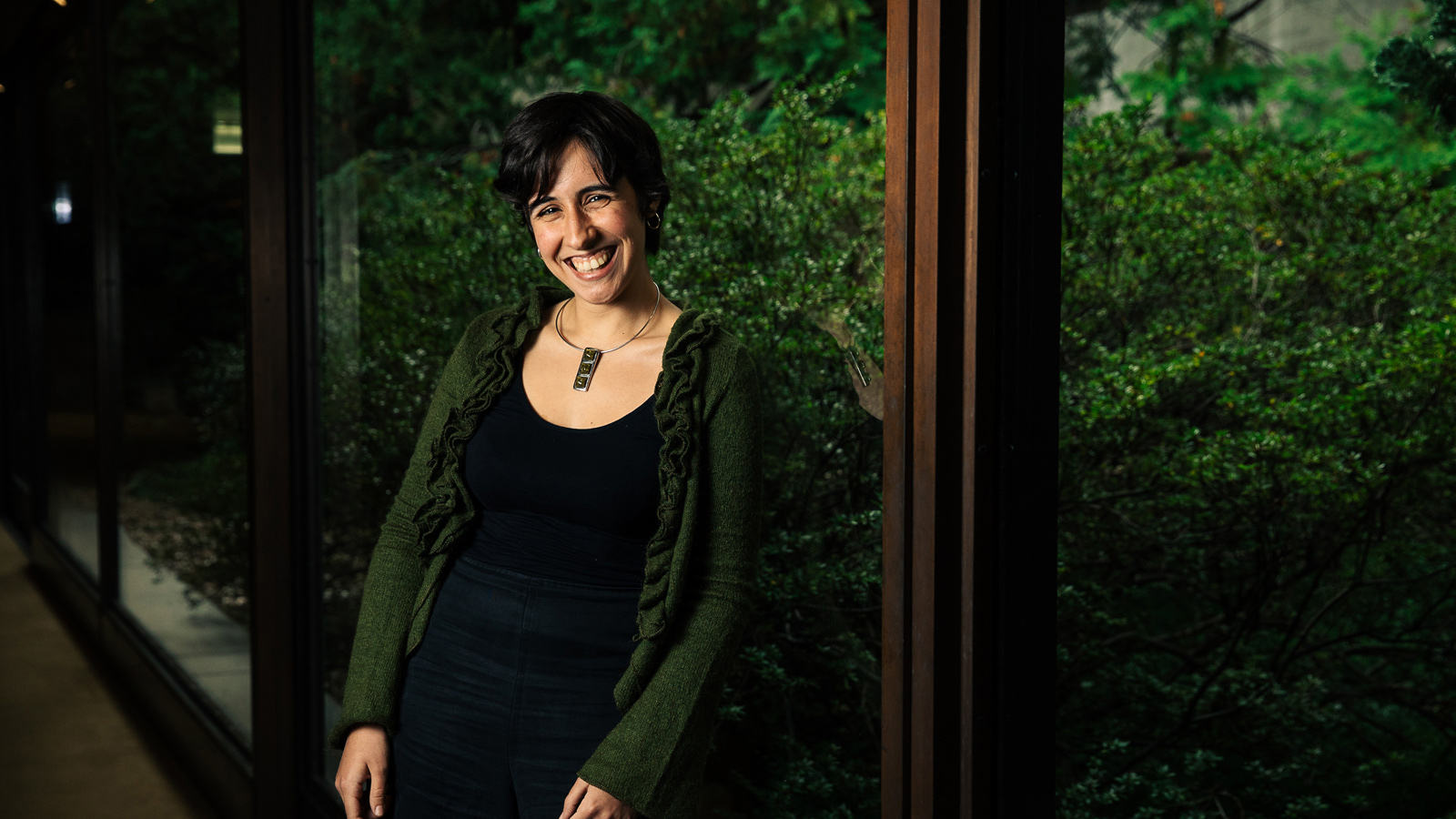‘There is a great desire for CAM to be a community space, a space that is open and lets people breathe.’
What made you want to take part in the Youth Advisory Group? What were you expecting when you applied?
I took part in ‘Gulbenkian 15-25 Imagina‘ in 2020 and then again in 2022. It was a fantastic production and programming project carried out especially for International Museum Day. Throughout this project there was always a desire on our part to continue a connection with Gulbenkian and to continue with the project, because we felt it was necessary to have young people inside the institution.
So, almost like a wish come true, this programme appeared. Fulfilling a wish but also a promise that had been made to us that we had opened a door and that that door would not close. When I saw this opportunity I immediately thought I had to apply. I only saw the position advertised on the last day of the application period and sent in my proposal without a second thought.
My expectations had already been raised by that previous project. A colleague from that project said that we should be like an octopus, which touches and moves every part of the institution. The octopus transforms itself and is an extremely intelligent animal. It’s a very beautiful metaphor.
That was the expectation I had when I joined this advisory group, that it would be like an octopus. We’re going to get inside the cracks in the rocks and see all the caves, all the nooks and crannies. That’s democratising the arts and reaching younger audiences. That’s what I wanted.
You mentioned ’15-25′. What was it like taking part in that project before joining the Youth Advisory Group? What are the differences between the two projects?
They are fundamentally very different projects. In ’15-25′ we developed a programme dedicated to International Museum Day in 2020 and the process ended up being interrupted due to Covid. We were already programming activities, building, planning themes and getting in touch with artists. Then it all had to be transformed and modified.
It was impossible to carry out the programme, people had to stay at home. So we ended up holding conferences, online talks with artists, historians, philosophers, teachers and activists. And then in 2022 I took part again, but with a physical programme inside the museum.

This Advisory Group, as the name suggests, exists for us to consult. To advise the museum or CAM, to suggest changes, give opinions, write measures… they really are different experiences. All valid, all incredible, but with very different processes.
Before these two projects, what was your relationship like with the Foundation and CAM?
It’s been a long and very emotional relationship because I grew up in Lisbon. Despite being from Porto and having moved back to Porto, I spent my entire childhood in Lisbon. And I spent a lot of time inside CAM, in CAM’s learning service and also with the CCB’s educational service. I spent a lot of time inside all these great institutions. I can describe the CAM building perfectly, even while it was under construction. I can draw what was there before because I have very vivid memories of the space, the exhibitions of artists who were invited, and the workshops I participated in.
That relationship continued and grew. I had a favourite tree and I have a beautiful photograph of me, as a child, hugging a tree in the Garden. It was my tree and the photograph is on my bedside table because it’s really important to me. I have a very emotional relationship with this space, not just with the Garden, but also with CAM.
This relationship ended up transforming me and I ended up pursuing art as an adult. These memories are a point of reference for any artist, for their own research. Then everything changed again because I also went into production and ended up taking part in various projects, and now I’m here.
As a member of the Youth Advisory Group, what do you think young people expect from a cultural institution today?
That’s a complicated question. I can’t speak for all young people. Speaking from my personal perspective, I think there is a genuine desire for communication, a desire not to be ignored.
Young people face a lot of fear, a lot of uncertainty. Suddenly we’re no longer children, we no longer go hand in hand with mum or dad to museums. We’re thought of as irreverent and childish, but we’re already adults, we’re beginning to have our independence. I think it’s a time of rebellion, but also of searching for identity.
An institution could also reflect this process of searching for and building identities. Of course it’s very difficult, we’re constantly changing, but that’s why it’s very important to maintain a dialogue between young people and institutions. Understanding that it’s crucial to talk about issues such as colonialism, gender equality, the queer community, feminism… all these topics are very important.
Young people want to identify with what’s inside the institution. Communication that is simpler and less formal, a neutral language that everyone can identify with. I think the crucial thing is identification. Everyone wants to feel at home wherever they are. They want to feel comfortable, to be able to open doors and enter an institution, to have a place.
The Youth Advisory Group has been running for several months now. What have the most memorable moments been for you so far?
The most memorable moment is always the beginning, coming in and realising who you’re going to be working with, since this work is only possible because there’s a group. It’s a group that, despite having very unique people with very different backgrounds in social and economic terms, is very united. There is a lot of diversity within our group and that is a strength.

I think the moment we met is what stands out the most. Realising that now we’re a family and we’re going to investigate together. That we are the little researchers. So the initial sessions were really important. Other moments were also important perhaps because of the presence of certain people. Institutions are made up of people, and seeing the people who work here and how they react when we talk to them or how they receive our criticisms and questions is what makes the biggest difference. There’s a lot of curiosity on our part and there’s always a response from the people in the institution.
I think this was very important when we went to Évora with the CAM director, the president of the Foundation and the boards of the different parts of the foundation. We realised that everyone was willing to listen to us and that this dialogue was really happening, that people wanted to talk to us.
There’s a mutual interest in getting to know each other and then there are small sessions of a more personal interest. I love the curatorial area, so I’m going to talk to the curatorial team. I already follow the work of those curators, so there’s a lot of interest on my part. I really enjoyed all the sessions we’ve had. They were all marked by little things. With the Live Arts team we felt like we got to roll up our sleeves straight away, it was different from the other sessions.
You have a background in various artistic areas, including the visual arts and theatre. From this multidisciplinary experience, what do you think a young artist would expect from a space like this?
A hybrid space, without borders. As an artist, I don’t really like to define which area I work in.
I come from music, I went to the music conservatory, but I have a degree in fine arts and a master’s in theatre. I come from all areas and when people ask me what I do, I say that I can show or talk about specific projects.
My interests change constantly. There’s a coherence, but I can’t say I’m from one area. I’m from the arts, full stop. And I think that’s what a young artist is all about at the moment and it doesn’t make sense to categorise them into different areas.
Maybe that’s what a modern art centre should be. It’s a centre, it’s the coming together of all these arts and all these different expressions of language and communication. In my opinion, that’s what a young artist wants from a presentation or exhibition space, to be listened to and to have room for exploration.
We’re very much in a phase of laboratory exploration, of investigating ourselves and observing the world. Few spaces allow us to just be or just show. The academy creates certain restrictions, asks for explanations, there isn’t total freedom. I think that if one of these institutions could give us a space to rehearse, a space to exhibit, a multi-purpose room that could be transformed, constantly rotating, I think it would be an interesting and different approach to the way things are done now.
So a space where work could be presented?
Yes, but not just a presentation space. More like a centre where there’s a community, because we’re often spread out and only meet at exhibition openings. There’s little crossover between areas: those in music go to music concerts, those in theatre go to the theatre, those in the visual arts go to exhibitions.
Of course there are people who cross paths, but there’s no centre that everyone goes to and that promotes this interconnection. I think such as space within Gulbenkian would be very significant. All these areas already exist, but they’re all separate. If there was a specific space for creation, for presentation and exploration, simply a space for the community, I think it would be interesting.
And what are institutions doing that is actually driving young artists away?
Institutions are a bit scary. Not just because of the historical burden they carry, but because there’s a sense of revolt as an artist. There is a very specific selection of the type of artists who enter, the type of themes that are featured, and this creates a barrier and even a repulsion towards institutions. And then people think: I don’t go to these institutions because they don’t give me space and they’ve never given space to people like me, artists who have been hidden from the history of institutions.
I have friends who say they don’t go to institutions because they don’t agree with what they have been throughout history, but I think we need to change this view. In relation to what they have been, there is still time to remedy this. There’s time to show that it can be different.
In your motivation letter, you mention that you worked on a project called ‘Viver ao Vivo‘ in three municipalities in the interior of the country. How did you feel culture was experienced in places far from the big city centres? Do you feel it’s a big difference?
It differs a lot because there’s a strangeness about it. I think Portugal has been very neglected in cultural terms, because all the money goes to Lisbon. In terms of opportunities and support, a large part is centred only in Lisbon and Porto, but especially in Lisbon. That’s why it’s always strange when programming in a place like that. People think: who are you to say what this is?
When you go to work in the countryside, you have to get very close to the community. I went to work in villages and small towns. There were community projects and also lots of concerts, mostly classical music. People immediately think that a group of elitists is knocking at the door. But actually there’s a lot of interest and a lot of need. You feel the community craving for it, even though they’re surprised when things do arrive. We were setting up stages for a concert in Linhares Castle, which is in the middle of a pile of rocks, and just to get the piano in there… imagine it… Suddenly, everyone in the village came to see how we were getting a piano there.
But then that brought people to the concert. There was a conversation within the community itself, the artists were staying in the villages and talking to the people. And then there were community works, community plays, concerts for children. There was a lot of involvement. And I think this is very different from the big cities, where there’s an audience that always goes to everything. It’s an audience that’s trained.
In the villages that doesn’t exist because there’s no continuous programme, and that’s why we continue to work within the municipalities. We feel there needs to be a continued interaction with this community, because there is a desire for that on their part. And it’s not a case of showing up, doing the project and leaving. There’s a connection to a story that has to continue.
We in the big cities sometimes feel that we have to take culture into the countryside, but we forget that it’s already there, we forget about its value and importance.
There are beautiful songs about field and factory work and that are being lost. There are lots of dialects that are being lost because nobody cares about them and people are forgetting them. Things that are not passed on are lost. And I’m not saying that it has to be people from the cities who go there, but as artists I think we have to go and talk to people and show them that what they do is also culture.
Do you think CAM could also help to reach these communities in some way?
Yes, there are so many projects that could be done. So much support that could be given.
More grants for students and for community projects that could be done outside Lisbon and its surroundings. There are many projects that CAM already does to help communities on the outskirts of Lisbon. I could be completely wrong and there could be several projects spread across the country already, but it really seems to me that most things are centred on Lisbon or the metropolitan area.
And I think it would even be in CAM’s interest to realise what lies beyond these boundaries. What exists within these villages that aren’t even that many kilometres away. It’s very gratifying to have worked in different areas of the country because I realise that, despite being considered a small country, we have a lot of wealth and I think CAM would benefit greatly from going to different parts of the country.
At the start of the project, you chose two works from the CAM collection, Helena Almeida’s ‘Desenho Habitado’ and Rui Valério’s ‘Duet’. Why did you choose these two works?
Helena Almeida is one of the most fascinating artists we have in Portugal. She is historically important and I have always felt a lot of affection for her work. I run to any exhibition if I hear her name.
This particular work is a performative drawing. It’s a series of photographs in which she takes a drawn line and there’s a change. Is it her? Or the drawing? What is the drawing? It’s a questioning of identity. Helena Almeida is an expert at this. She really is one of my favourite artists and I really wanted to see that particular work.

Regarding Rui Valério’s work, I admit that I did some research. I saw almost the entire catalogue of works in the CAM Collection, if not all of it, and I became very interested to see what kind of installations had come into the collection. The field of installation is fascinating because it’s a hybrid field that mixes different areas and I already knew some of Rui Valério’s pieces.

He produced compositions and graphic scores of sounds, which is a work I also enjoy, and I was very curious to know what sound came out of those loudspeakers. I’m driven by curiosity and discovery. And when I saw this piece I was immediately intrigued as to how it happened, what it was like in space. There are lights, there are two microphones… is it a duet? Do people go there and talk into the microphones? I wanted to be transported to the moment when that work was on display. That’s why I chose it.
What are your expectations for the reopening of CAM?
There is a great desire for it to be a community space, an open space that lets people breathe, a meeting place. Such meeting places are very important and it’s not just a meeting place for the arts but for all people, a meeting place for communities.
This is what I want CAM to be. That everyone feels welcome when they come in, that they feel they have an opportunity, a voice. That even the people who work at CAM feel they are listened to, from the director to the person sweeping the floor, to the security guard. That everyone has a space to speak and ask questions.
Suggestions
Book: ‘Grapefruit’, by Yoko Ono
Music: Album ‘Se Ve Desde Aquí’, by Mabe Fratti; album ‘Tutu’, by Miles Davis; Playlist ‘Women In Revolt! x Tate’; ‘Altas’, by Meredith Monk
Artists: Fluxus Movement
Filmes: ‘Russian Ark’, by Aleksandr Sokurov; ‘Animal Farm’, by John Halas and Joy Batchelor

